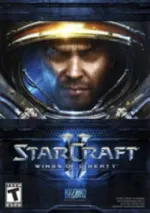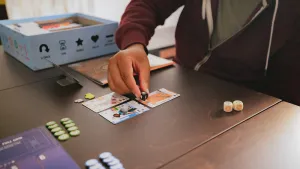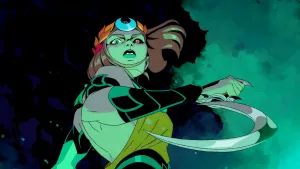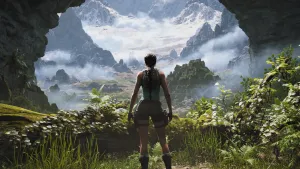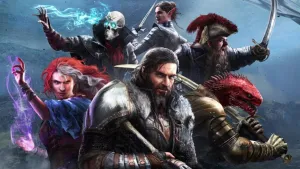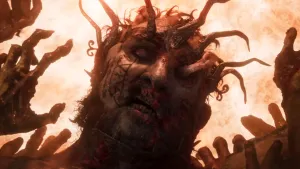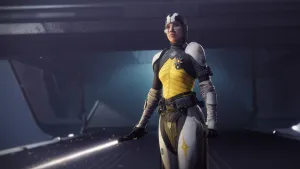Lead Designer Dustin Browder On Story And Map Design In StarCraft II
Earlier this week, we posted an interview with Diablo III’s game director as an online extra for our preview of Diablo III from issue #199 of the magazine. “But wait,” you cry, “that issue also had a preview of Blizzard’s other upcoming hotly-anticipated sequel, StarCraft II! That deserves an interview too!” Had you in fact cried as such, then I must admit that you are correct.
With that in mind, I gave StarCraft II lead designer Dustin Browder a call. We talked about where the races and characters of the StarCraft universe stand at the beginning of this new game, how long it takes Blizzard to create a single campaign mission (and how often they throw them out), and how they’ll be trying to pull crappy players like myself into StarCraft II’s multiplayer. Check out the full interview below!
Game Informer: In our magazine preview, we focused on the competitive multiplayer and Battle.net features, but I’m really into the single-player narrative stuff personally. How much of your audience would you estimate is more interested in the single-player content? How much of a focus is that for you guys?
Dustin Browder: It’s hard to know. We know that a decent percentage of players never log on to Battle.net. I have heard -- and I don’t know if this is true -- that as many as half of our players don’t log on to Battle.net. We know that those numbers, I guess they could be playing Skirmish, but they’re probably playing the single-player campaign. Those numbers are substantial. But ultimately the exact numbers don’t matter to us that much. If the solo play experience is going to be in the box, it needs to be the best possible solo play experience that we know how to do. We’ve been focusing the design on the solo play experience pretty tightly for the last six months. That’s been our major focus. We haven’t been doing that much work on multiplayer during that time.
GI: I’m really curious to see how this works in practice, but I was nervous when word broke that the Terran campaign will be non-linear, allowing you to choose mission at will. How does this affect the tight linear storytelling that you had in the first StarCraft?
DB: It’s still something we obviously want to continue pursuing because we want the game to begin in one place, and since we’ve got games to come after this one (not to mention books, graphic novels, and all the rest), we want the game to end in a consistent place as well. There’s definitely a beginning, a middle, and an end that you will experience that is linear. I don’t want to say that the plot is non-linear. The way you go through it is up to you, but you will experience the same beginning, middle, and end as everybody else. It’s the stuff that happens in and around the middle that’s up to you.
GI: Is it possible to miss certain characters or story events depending on how you tackle missions?
DB: It is possible, but you would have to do it on purpose. There’s a couple points in the game where we ask the player to make a left or right choice, and there’s no going back. But those are very rare, and when we do them, we offer them up in a very obvious way. “Okay, now this is left or right, choose.” Even then, we offer easy ways to see what would happen if you had gone the other way. We know you’ll just save and reload to see what it was anyway, so we offer some easy menu stuff that you can go through to see what would have happened if I’d decided to help that character instead of killing that character, for example. So nothing is forcing you to miss any content.
There will be times when characters come up on screen and say, “Oh my god, our planet’s under attack by the Zerg! You have to help us now!” but it’s like a World of Warcraft quest. It’s not right now. If you come back in a week, they’ll still be there with the same problem, and you’ll still be able to help them. There are a couple places where we demand that you make a choice, and we force you to pick a side, but for the most part it’s up to you when you want to get to this stuff. It’s very easy to see almost the entire game in one playthrough, and if you didn’t want to play through again to see the other stuff, there’s some easy ways for you to see what the content was that you chose to miss.
GI: Are those choices going to affect the overall story of the game? Or are they more along the lines of choices that might affect a character who’s with you in the campaign?
DB: It’s more like that, affecting characters who are with you throughout the game. Like I said, the ending is the ending. It’s such a character-based game, driven by these characters we’ve become invested in over the last 10 years. We want to see what’s going to happen to Raynor. We want to know what’s going to happen to Mengsk. What’s the fate of Kerrigan? All these things are all very interesting to us, and we hope our fans think so too. We’re going to tell a single story. When you get done, there will be questions on what happened to these secondary characters. What you chose will affect what happens to those characters. We probably won’t revisit those characters again down the road simply because it was up to you what happened to them. It wasn’t up to us. But the major characters are still up to us, so they’ll have a very clear story.
GI: Are the other campaigns going to be similarly non-linear, or will the Zerg and Protoss campaigns be more structured?
DB: I can’t say for sure, but it’s certainly our intent to make them in a similar structure. We’ll see what the reactions from the fans are as well. If the fans come back and say they liked it or they didn’t like it, then obviously we’ll course correct.
GI: From a narrative standpoint, where do the various forces in the StarCraft universe stand at the beginning of the Terran campaign? Is the UED still around at all after their defeat in Brood Wars?
DB: The UED is a bit of a mess right now. They’re not really much of a factor in Koprulu sector politics. They’re kind of out of action. They may play a role, but it’s certainly not giant fleets of weapons and battle cruisers at their command. The Dominion is still firmly in control of their area of space. The Zerg have gone into torpor. We haven’t heard much from the Zerg in the last four years since the events of Brood Wars. No one really knows why. It’s an open question: What is Kerrigan up to? What are her plans? What are her intentions? What is she going to do, if anything? This has given Mengsk time to reconsolidate his position and really dig in. It’s put in Raynor in a tight spot. He’s been working as a mercenary, a pirate, a rebel, doing everything he can to destabilize Mengsk’s government, and he hasn’t really been all that successful.
GI: The Terran campaign is going to focus on Raynor. I’m excited about that, because he’s one of my favorite characters from the first game and, I think, one of the most interesting characters in any video game.
DB: Thanks!
GI: Yeah, he’s been one of my favorite characters in video games ever since I played the original StarCraft. But by the time the events of Brood Wars were finished, he didn’t really have a lot of allies left. How does he build up the resources necessary to command an army in StarCraft II’s campaign?
DB: He’s definitely on his own. He’s definitely alone right now. As things heat up in the StarCraft universe, as this campaign begins, the opportunities for mercenaries, pirates, and rebels are pretty thick. There’s suddenly a lot of money available for men with his skills. It allows him to buy the necessary equipment. In addition, the hatred for Mengsk has really built up over the last four years and has rallied more and more Terrans to his cause. He doesn’t really have a nation at his command, but he’s getting a larger and larger group of people that are willing to fight and die to overthrow Mengsk. It’s up to Raynor with the player’s help to get the necessary technology to arm these enthusiastic soldiers to put up a serious resistance.
GI: As the campaign progresses, in addition to making choices about what missions to go on, you also get to make choices about which technology you want to research on a sort of grand mission-to-mission scales as well?
DB: Yes.
GI: How will that work in the game? Do you get a certain amount of resources depending on mission performance?
DB: I’ll explain it where we’re at now. It does shift a little bit as we go, but I’ll certainly tell you where we’re at. There are several ways that you can improve your army over time. Every time you go on a mission, you have a character called Swan who’s in the armory on your ship. Every time you go on a mission, he prepares a special weapon for that mission.
So if you’re going to take on the Zerg and help rescue a planet, Swan might prepare Firebats for you. This unit will be really key to the mission. The unit will usually be very effective on the mission. Depending on the mission, sometimes you have to use it a little bit more in concert with other units, and sometimes you can use it a little bit more solo. It depends on the mission and the nature of the unit. Swan has got those units either from blueprints that he’s begged, borrowed, or stolen from the black market or from stuff that he’s put together himself and invented. He’s always there for you preparing the right weapon for the job.
Once you complete a mission, generally speaking, you’re paid. You’re often acting as a mercenary or as a pirate, so you get some sort of cash from any mission that you do. You can then take this cash back to the armory to Swan, and then he can take that cash to the black market, and he can buy you upgrades. So after you finish a mission, there’s usually several upgrades available for whatever technology you just got, plus there’s upgrades for other technology that may have come online since you were away and upgrades from previous technologies that you may not have purchased. Depending on the mission and what you’ve bought, there’s sometimes as many as eight or ten different choices after a mission. There’s usually not less than six. So then you decide, you know, the firebats are cool, but I really like the siege tanks, so I’ll save my money and get those upgrades. Or if you think the firebats are amazing, you can buy all the upgrades available for the firebats.
GI: And again, is this a system where by the end of the game, you’ll have amassed enough wealth to have purchased every upgrade?
DB: Unlikely, no. In this case, you’ll have to make some choices. Our current thinking is that at the end of the game, around two-thirds to three-quarters of the technology will have been purchased.
GI: You mentioned with the storyline choices that there will be an easy way to go back and experience that. Will there be any way to go back and try out technology that you didn’t purchase but want to try out.
DB: In this case, with our current thinking, you would have to replay, but I don’t know if that’s good thinking or not. That’s just kind of where we’re at. We think allowing you to see all the story stuff is a more delicious piece of candy than a tech upgrade on a firebat, but certainly as we play through, we may find some way to make those technologies available to you for testing.
DB: Another way you upgrade your army is through mercenaries, which you can hire. They’re kind of like the StarCraft equivalent of hero units. You’re only allowed a certain number of them on any given mission. They’re fairly expensive, but they’re also silly powerful.
GI: Are the mercenaries all named characters with unique voices and personalities?
DB: Kind of. You’ll hire the siege breakers, which is a special mercenary unit with special art. They’ll be very similar to siege tanks, but they’re much better. So you’ll hire the siege breakers to join your army, and they’ll be available. You can maybe bring four siege breakers to any given battle. After that, that’s all you’re contracted for for any given fight. So you’ll spend money to hire these guys. There’s things like Duke’s Revenge, which is a pirate battle cruiser that you can bring to any mission.
If a mercenary unit dies, it’s cool; you’re not going to get it back that mission, but you’ll get it for the next one. It’s a simpler version of heroes than Warcraft III. It doesn’t involve the Altar of Storms and all of that stuff. Warcraft III was built around that mechanic, and StarCraft II is not, but we still really dig the idea of having some of these specialist characters with their own kit and gear. This allows us to do that in a big army game. You get these guys that are really powerful. You’re invested in keeping them alive, but if you do happen to lose them, it’s not the end of the world.
The final upgrade method that we’re still sort of working on is the idea that as you play battles against the Protoss and the Zerg, you capture or kill various Protoss or Zerg weapons, creatures, artifacts, DNA strands, whatever you can get off these aliens. You can take these back to your ship and give them to the scientists on your ship, and you can actually get some research out of it and get some additional technologies.
GI: In that case, are you getting new Terran technology or a Terran approximation of Zerg and Protoss technology?
DB: It depends. We’re still looking at all the things we can do, but it might be things that are clearly Terran but are designed to work against the Zerg. Or sometimes it could be Zerg-inspired upgrades for the Terrans, like you just described. It could be regenerative abilities for some of the infantry units. It’ll be some crazier stuff that ultimately we feel is fun but not super-useful, so you probably wouldn’t spend money on it…or stuff that’s so powerful we wouldn’t want you saving up your money for it. It’ll be one or the other, stuff that’s just utility or stuff that’s silly powerful that will be really fun to play with.
GI: Keeping in mind that this type of upgrade progression is not quite finalized, as you said -- are you imagining that as a system where you hunt down a specific unit in a mission and kill it to get the part or is it more of a random drop kind of thing?
DB: No, it’s specific, and we’ll tell you when you enter the mission what the research objectives are for that mission. We want players who are maybe having an easy time with the game – which will happen depending on the difficulty you choose. We do the best we can to get players to choose the right difficulty, but it’s in their hands. If a player who’s really great decides to play on normal, he’s going to get bored, right?
So we’re trying to give players ways to stretch themselves should they find themselves in that situation. Research objectives and other bonus objectives serve that function. If you find that a certain mission for whatever reason -- either you’re really good or you just get it -- this one’s really easy, you’ll realize you can fly out and kill the Zerg brutalisk, and if you do it, you’ll get four research points. It’s a way to stretch yourself and get some bonus stuff. Also, if you want to try to get everything in the game, it’s a way to challenge yourself and make the missions more interesting.
GI: I’m going to have to put a big SPOILER WARNING FOR BROOD WARS here, but one of the really intriguing hooks that game ended on was the revelation of the Zerg-Protoss hybrid that was being created. Is that an idea we can expect to return during the StarCraft II saga, or is the game going to stay more focused on the conflict between the Zerg, Protoss, and Terran right now?
DB: That’s a really interesting idea, isn’t it?
GI: Yeah.
DB: Uh-huh…. I wonder what we’re going to do. I really don’t want to say on that point. Obviously we’ve got some story plans. Obviously we’re not ignoring everything that’s come before. We’re not throwing anything away. How much the hybrid will figure into the Terran campaign…players will just have to wait and see. It’s obviously something that will be a continuing factor in the StarCraft universe.
GI: That’s all I was looking for really.
DB: Fair enough. It has not been forgotten.
GI: It’s just that since Brood Wars was an expansion and all, maybe you guys were just like, “Ah, throw it away.”
DB: No, that’s real. It’s an important part of the lore and an important part of the fiction.
GI: So the Terran campaign’s going to be focused on Raynor. Blizzard has said that the Zerg campaign is going to follow Kerrigan. Is there a single character at the head of the Protoss campaign? Maybe Zeratul?
DB: There’s a lot of arguments about that right now. You should come to our design meetings and listen to us battle about that one. Maybe Zeratul. Maybe Artanis. We don’t know. Maybe we’ll come up with another character. Those are the two likely candidates. Certainly Zeratul is a strong choice.
GI: That’s my choice, if you want to mention that to everyone else.
DB: I will! One more vote for Zeratul, cool. You and I are together on that.
GI: One of the coolest things revealed at BlizzCon for StarCraft II was the new map editor and how flexible it is. You showed off the ability to create some old-school shoot-em-up levels and over-the-shoulder third-person shooter levels. Can we expect some of the single-player campaign missions to twist the gameplay in unexpected ways like that, or are you largely sticking to more pure real-time strategy for those?
DB: Mostly pure. We try to do everything we can to make each mission feel unique. We don’t tend to go to places where you have to relearn the UI. That feels a little bit too far. We definitely have commando missions, missions on alien space platforms where the laws of reality are different, missions where you’re fighting against rising tides of lava, and you have to keep moving to higher and higher ground. We’ve got missions where you’re fighting against swarms of infested Zerg that only come out at night and hide in the ground during the day, so you have to hold out at night, and then you run around with your flamethrowers and burn everything out during the day, and then run back to your base at night.
We definitely try to create each mission as its own unique mini-game with its own unique mechanics so you don’t feel like any given mission plays anything like a Skirmish. If you wanted a Skirmish level, you’d just go play Skirmish. We try to make sure each mission has its own story and its own unique tactical problems for you to figure out and overcome and deal with. But we don’t want to do stuff like suddenly put you in first-person shooter mode.
GI: I know the current plan is for 25 to 30 missions in each of the campaigns, which would make a grand total of nearly 90 missions between all three releases. With so many missions planned for the overall StarCraft II saga, how do you approach keeping everything fresh? You gave some examples there of how you’re doing that with some of the missions planned for the Terran campaign, but how do you approach keeping that for all 90 missions over this whole long stretch of releases?
DB: It’s hard work. (Laughs) It’s sort of a mystery. I had this discussion with Mike Heiberg, a senior designer who’s been working here for almost 12 years. After we get done with every mission meeting, he rolls his eyes and says, “You know what? I didn’t think we could possibly come up with a new mission idea, but we just did.” He’s been doing this for 12 years, and he can’t believe we keep getting new ideas. But we keep walking away with new ideas. I don’t know what to tell you as to how it’s done. We just seem to find ways.
To be fair, we do sometimes repeat mechanics, but we’re aware at a very basic structural level what a lot of the mechanics we use are, and we find ways to riff on them. It’s like how a football coach has certain plays, and he runs those plays, we have a library of several dozen “plays” that we know that we can riff on, alter, and change to the point that they feel like very different missions even though at their roots they are somewhat similar. But throwing that in there with a mixture of different technologies for each of the races and new technologies being invented for the game, and you start to get a very large world of possibilities.
It really is limited at the end of the day only by our creativity. We’ve got a design staff of 10 guys, many of whom have been on at Blizzard for 10-plus years. It’s a pretty creative bunch. Certainly it’s a lot of work, and it’s always a daunting task every time we look at one of these games. We’re terrified we’re going to mess it up, that we won’t meet our expectations, or worse yet, that we won’t meet the fan’s expectations. But with a lot of effort, we do seem to somehow carry through.
GI: When a designer comes up with a new idea for a level, how long does it take to turn that into something playable?
DB: Playable is sometimes as little as two weeks. Good for Blizzard is often three to four months. It never works the first time. A good screenwriter will tell you that they rewrite a script six or seven times. We have a similar approach. We often retune, rewrite, and change missions five, six, seven, eight times as we’re going through them. We want to really tune them to a high level of polish. Sometimes if we’re lucky a mission doesn’t change in its roots that much. It just kind of gets better as it goes. Frequently, though, we find out that idea that seemed so great a month ago is actually not that great. Once you dig into it, it actually falls apart.
GI: So do you actually end up just completely dropping ideas?
DB: Often. Way too often. It’s exhausting, but we totally do. We frequently will throw out whole missions and say, “Too bad it’s not. Let’s start again.” It’s one of the pleasures of Blizzard and also one of the things that’s most frustrating for us and even for our fans. It definitely allows us to make high quality work, but it also delays the game.
GI: I guess that makes sense thinking back to some of the presentations Blizzard has done on whole games that you’ve thrown out without even revealing them. It makes sense that it would happen with individual missions as well.
DB: And it happens with units, and it happens with abilities, and it happens with UI. It’s so important for us to be prototyping. It’s so important for us to be playing. None of this can really happen on paper. It all has to happen in the game, so we can really feel it, try our best to experience it as our fans will experience it, and really give them something quality.
GI: One thing I have to ask about that was also announced during BlizzCon was Achievements. You said StarCraft II will have Achievements and that you’ve improved the Achievement system in the game compared to the one in World of Warcraft.
DB: We have? I don’t remember us saying that. I hope it’s a good Achievement system, certainly, but I don’t think it’s fundamentally that different from World of Warcraft’s.
GI: I wish I had the actual quote here now, but I remember it from the Battle.net panel….
DB: Maybe what it refers to is that it ties into some in-game rewards, although World of Warcraft’s Achievement system does as well. You can get certain Achievements in WOW and get non-combat pets or mounts. We’re doing something similar with StarCraft II that we think is really cool. You get different avatars that you can display on Battle.net. We’re also giving you the ability to unlock decals, which can be applied to your units in-game. That will be for Skirmish games and for multiplayer games. Obviously in the campaign you’ll always be flying Raynor’s Raiders symbols on your characters, but in multiplayer and Skirmish you’ll be able to fly your own flag. That will depend on which Achievements you’ve earned.
GI: I’m only asking, because I’m an Achievement junkie.
DB: Yeah, I’m right there with you.
GI: Do you have any examples of the kind of Achievements we can expect in StarCraft II? I’m sure there’s the regular "Complete this mission" kind of Achievements….
DB: Yeah, there’s the “Complete mission” Achievements. Obviously for multiplayer there’s "x number of wins for Zerg and Protoss and Terran." There’s some cooperative Achievements planned. One of the funniest ones that we’ve talked about is an Achievement called “Rock Lobster.” There is a giant Zerg creature called a brutalisk on a map that has lava rising and falling every five minutes. If you can trick the brutalisk -- the "lobster" -- into the lava and kill it with the lava, that’s worth an Achievement. We’re trying to do some fun ones, but obviously a lot of them are really meant to be -- as an Achievement ***, I’m sure you’ll appreciate this -- completionist and playthrough, so you can really go for a lot of these and see a decent number of rewards just by playing through the game in a normal way.
GI: I like the fun ones too. I like that there’s room for those.
DB: You want a mix. You want a decent amount of Achievements for playing normally and doing well and getting some candy. And you want some that make you say, "I have to do what now? Oh my god!" The kind that push at your comfort level a little bit and ask you stretch as a player.
GI: I think I’ve made it very obvious here with the flow of the questions, but I’m much more of a single-player guy than a multiplayer guy. I have done a little bit of StarCraft and Warcraft III multiplayer,though, so I should probably ask at least one question related to that. I know from BlizzCon that you’ve got some cool additions planned for multiplayer such as the ranking system. Is there anything specifically designed to help pull in gamers who are intimidated by a community that’s known for being extremely hardcore?
DB: That’s a long question, but I’ll do my best to answer it quickly for you. We’ve got a number of tools to try to work on this problem. I can’t say for sure how successful we’ll be, but we’re giving it our best effort. Obviously we’re going to have a decent number of tutorials for Terran, but also for Zerg and Protoss since you don’t really play them throughout the single-player campaign for this first release.
We’re going to have something we’re calling Challenge Maps, which are interesting puzzles for you to figure out, but they also teach you the basics fundamentals of most of the things you need for multiplayer. They teach them in such a way that you won’t be able to complete the challenge in any sort of respectable level until you do them "properly." They’ll teach you how to micro a little bit. They’ll teach you how to use counters correctly. They’ll teach you how to use resources correctly, which is probably the biggest mistake that most new players make in StarCraft. We’ve got these tools to set you up.
We’ve got Achievements for the Skirmish system, which will hopefully pull some players into playing on Skirmish before they jump online. We’ve got a practice league, which has anti-rush maps. That should encourage players to practice online and play in an environment that’s still fundamentally competitive, but it’s a little bit slowed down from what you’re used to seeing. The practice league will also feature gameplay speeds at Normal speed instead of faster settings. That will help new players get in.
Once you’ve gotten through all of these things, if you’re still scared, the reality is that we’ve also got a ranking system that should be matching you against players of your skill level no matter how bad you are. No matter how bad you are, you should be playing against guys at your skill level. You will win about half your games. If you’re a player who wants to play competitively and wants to win 80 or 90 percent of your games, there’s not much I can do for you. In order for that to happen, someone else would have to be losing 80 or 90 percent of their games, and that would make that person sad. The best we can do is 50 percent.
We can and did for the most part in Warcraft III put players into an environment where they could win half their games. Now Warcraft III had a few problems that we’re solving with a lot of the new Battle.net stuff. For instance, in Warcraft III you could reroll your account any time you wanted to and just start from the bottom again. So you’d be hanging out down there at your low-level skill having a good time against people at your level, and about every one to five games, here comes this badass rolling through the lower ranks, just cleaning house as he’s resetting his rank. Now there’s a limited number of accounts per box. That’s not going to happen nearly as often. Occasionally you’ll encounter someone who just bought the game, who we’re still figuring out how he ranks, and he happens to pop into your game, and you get a little bit of a beatdown. But for the most part, that shouldn’t happen.
The final thing that we’re doing for more casual players is that we have a much more extensive score screen that gives you actually useful information about how to improve your game. It compares it directly to your playing. It’s not just a question of how many units you killed versus how many units he killed. You know he killed your units. You watched! That doesn’t tell you anything. What might be useful to you are things like how much money did you gather over time. You can look and see, “Oh my god, at the end of the game he had 10,000 more minerals than me. No wonder I lost! Let me watch the replay and see what he did.” It gives you all the information -- well, not all the information, but as much information as we can fit reasonably in a practical score screen -- to help you become a better player.
At the end of the day, StarCraft multiplayer is about building up your skill. Just like any first-person shooter, you’re there to have a good time, but you also want to learn something and get better as you play. We’re trying to provide players with enough tools so they have the information so they can improve their game, whether they’re wanna-be Korean pros or my mom first coming into it. We want to have the tools available so that every player can improve their game and just have more fun.

Get the Game Informer Print Edition!
Explore your favorite games in premium print format, delivered to your door.
- 10 issues per year
- Only $4.80 per issue
- Full digital magazine archive access
- Since 1991



